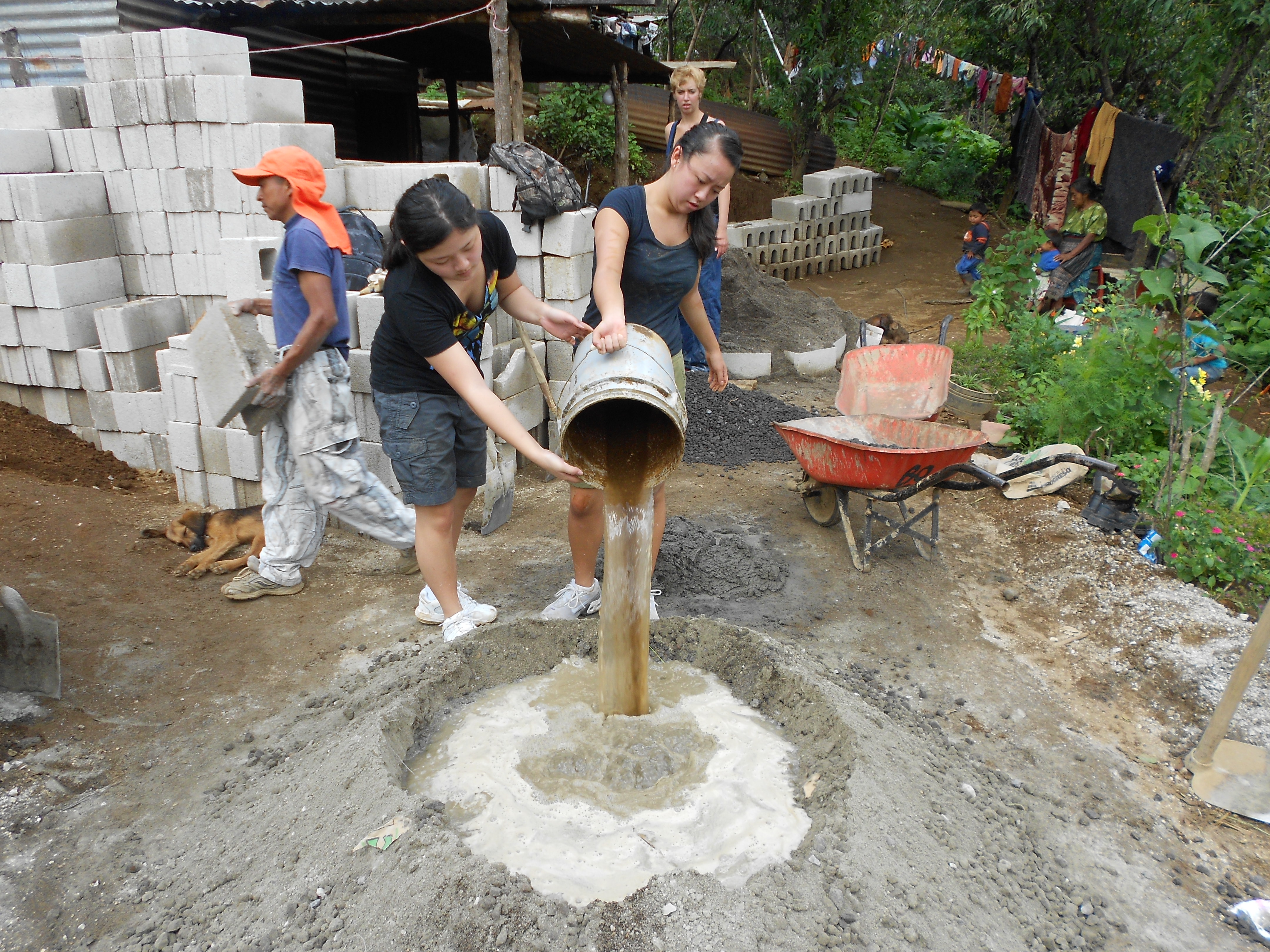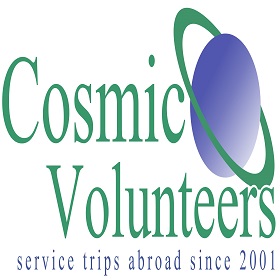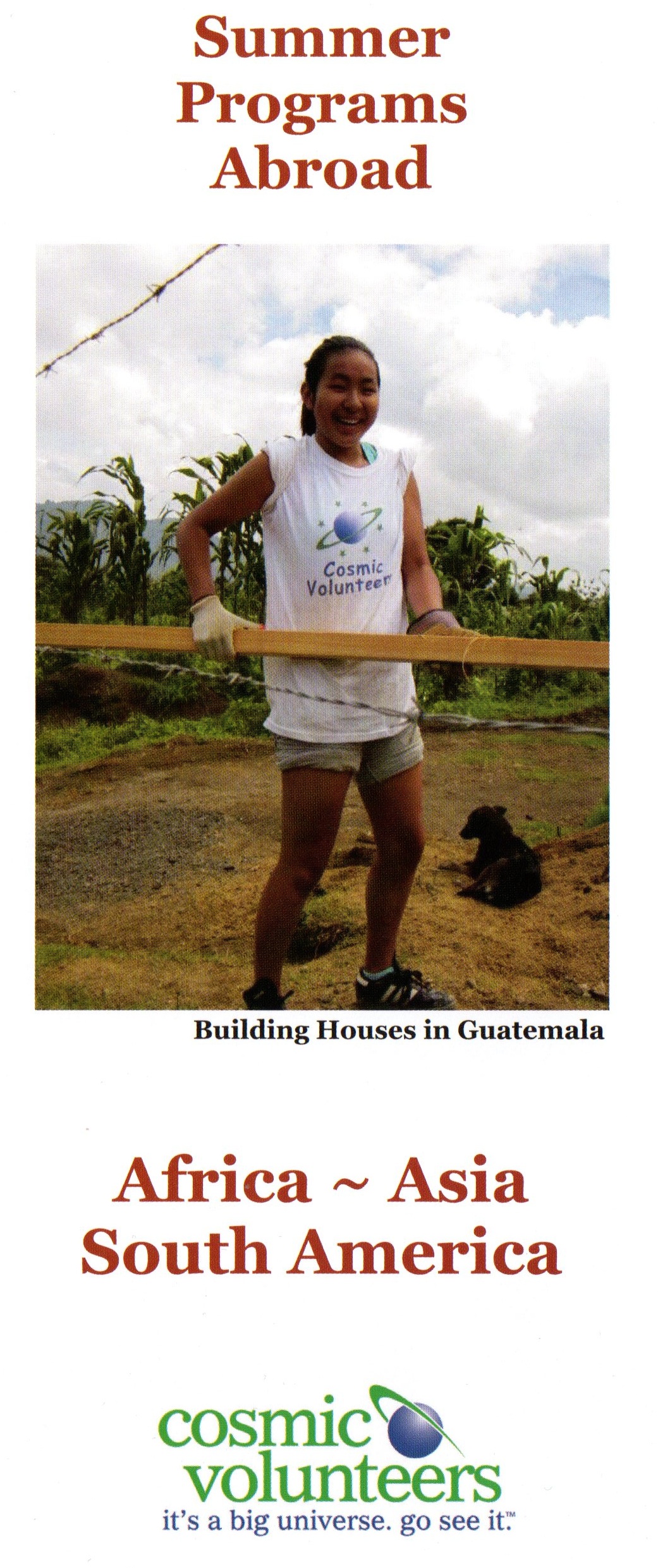
Category: Volunteer Abroad


Volunteer Abroad For Free
The idea of volunteering abroad for free is gaining in popularity.
Especially after the sticker shock when browsing organizations online who charge thousands of dollars for just a short stay abroad.
So yes, the word “free” sounds very inviting when it comes to volunteering abroad. Let’s take a look at some things involved with volunteer abroad for free.
What does “Free” mean?
First let’s define “free” in the context of volunteering abroad.
“Free” means that the volunteer does not pay a program fee to a third-party placement organization. Instead, the volunteer decides to arrange and pay for everything on their own.
As the old saying goes, there’s no such thing as a free lunch. There’s also no such thing as a free volunteer trip abroad.
The “Program Fee” model
Paying a program fee to an organization has become one of the standard options today
for newbies to volunteer abroad. The “placement” organization is typically a non-prot
entity that is independent, secular and unaliated with a school or government entity.
The program fee they charge (sometimes also called a “placement fee”) pays for a
volunteer’s meals, accommodations, airport transfers, insurance, visa assistance,
pre-departure advice, 24-hour emergency support, and the volunteer placement itself.
One way to volunteer abroad for free is to simply self-arrange your trip. This means that that you will not have to pay a program fee to an organization.
Show Them the Money
However, the reality is that unless you have the time, money and a strong personality (and some luck), self-arranging a volunteer trip overseas can end up costing the same or even more as with paying a program fee.
How can that be?
First, even if you avoid paying a program fee, you will still be responsible for paying for items that the program fee would have covered. As I mentioned above, these costs include things like meals, accommodations, airport transfers, and daily commutes to the volunteer job.
Second, there will likely be costs for you to nd a volunteer placement on your own:
1. Time
Before you leave home for your volunteer trip overseas, there will be the “opportunity cost” of spending dozens if not hundreds of hours on the Internet and phone researching and vetting potential volunteer placements abroad.
2. Travel
Then when you finally arrive in the host country, you will have to spend money visiting those potential placements. This means paying for your ground transportation, meals, and accommodations.
3. “Optional” Donations
Most local organizations in the host countries (like orphanages and AIDS groups) “require” volunteers to make a cash donation (which can be as high as $500) in order to volunteer at their facility. These donations are usually not published or requested directly by the facilities; Instead the managers will constantly bombard the volunteer with tales about the facility’s lack of funds, until it’s uncomfortable for the volunteer NOT to donate cash or goods.
4. Emergencies
Most volunteers abroad do not experience an emergency during their trips. However there is a chance that something catastrophic will happen to you such as a medical episode, assault, theft, or natural disaster.
Would you be able to handle a an emergency on your own? Would you understand the importance of pre-departure recommendations like buying travel insurance, registering your trip with your local embassy, carrying emergency contacts on your person, and having access to copies of important documents like passports and visas?
Who should volunteer abroad for free
Volunteering abroad for free is not for everyone. But there are certain types of people and travelers who can thrive in this situation:
1. Experienced Travelers
If your volunteer trip abroad will be the first time you’re traveling overseas — especially if still a minor — strongly consider signing up with a volunteer organization and paying their program fee. Volunteering abroad for free is for those travelers who are accustomed to handling the experience of being abroad independently. This includes things like haggling with taxi drivers, finding accommodations, and staying safe.
2. Those with time on their hands
Don’t expect to quickly nd a volunteer placement that suits you, especially if you are looking for a skilled position like in health care or construction. You will need considerable time to research and investigate not only the volunteer placement itself but also the local community. Then when you finally arrive at the placement, do not be surprised if the reality doesn’t match the “brochure” — in terms of the facility’s quality and the availability and type of volunteer work.
3. Tough Cookies
As one can gather from the above, volunteering abroad for free is suited only for independent-minded self-starters. What if something goes wrong 10,000 miles from home — say with your health or the volunteer work — or if you get homesick and depressed? You must be able to handle such adversity mostly on your own. You will have to negotiate a new culture with its unique customs, work styles and health and safety concerns.
4. Unskilled Volunteers
Volunteer positions that do not require skills or experience are the easiest ones to self-arrange. The most popular ones include volunteering at orphanages, elementary schools, and with sports teams. If you are a skilled volunteer like an experienced doctor or nurse, you will likely benifitted from the contacts and support of a placement agency.
How to Volunteer Abroad for Free
So, just how can you volunteer abroad for free? Here are some methods that work:
1. Former Volunteers
Seasoned travelers are often the best resource when nding a free volunteer project abroad. They are almost always willing to share their experiences — and not just on an impersonal blog or Facebook page. Ask them to have a chat online or even try to meet for tea if feasible.
2. Social Media
Facebook and Twitter can be a good way to find free or low-cost volunteer programs abroad. But again, focus on finding former volunteers, instead of just reaching out to the volunteer placements themselves.
3. Guide Books
Travel guide books (Lonely Planet, Moon Books) are good to consult for their listings of free volunteer projects abroad. These guide books are very popular, so the listed organizations are usually ooded with requests from foreigners looking to volunteer. Contact them anyway — they may have partner organizations who could use your help.
4. Local Organizations
Contact organizations abroad directly, like schools and drop-in centers for children, to see if they have volunteer placements available for you. Send an email or Facebook message but also call them on the phone (the effort of a voice call may make the organization more willing to entertain your request to volunteer). Ask if they have had foreign volunteers before; what are the work duties; is there free room and meals?
5. Just Show Up
Consider simply flying to the host country and arranging everything after you arrive. Have a list of local organizations in hand and literally knock on their doors and tell them you’re looking to volunteer. Don’t have a list? Hang around venues with foreigners like cafes, gyms and bars. Ask locals (hotel front-desk, taxi drivers, waiters) where you can volunteer. These communities abroad are very small — you will find something quickly.
(Volunteer Abroad for Free — PDF)

University Travel: 10 Ways Students Can Globetrot for Free
Freelance travel writer and food blogger Lauren Razavi outlines 10 ways students can travel around the world for free (or almost free).
Lauren posted these ideas several year ago, but I like them so much that I wanted to share them again.
And although Cosmic Volunteers volunteer programs abroad are not free, I still believe in sharing ideas on traveling abroad for free. We travelers are all about helping others abroad while learning about different cultures.
So, if you are ready to start thinking about and maybe even planning your summer for 2018, here are some ideas to explore about how you can travel around the world for free.
1. Cultural Exchange and Study
Each year, government departments and private organizations fund a limited number of undergraduates to go on cultural exchange programmes.
One good example is the China Study Tour run by the Confucius Institute. The study tour immerses students in the cultures and traditions of China. In order to keep the tour as affordable as possible, the Confucius Institute subsides the cost of accommodation and activities included in the tour program.
2. Teach English Abroad
Teaching abroad is a great option, especially if you are interested in going to southeast Asia.
There are small schools and community centers in places like Vietnam, Thailand and the Philippines that would be glad to have you for the summer. Your role would most likely be as an unpaid teaching assistant who practices conversation and pronunciation with young children.
I suggest looking online for small schools and child-advocacy organizations in the host country, then contact them to see if they can use your help. Some may even give you free accommodations and meals all summer.
Also look at directories like Go Overseas and Go Abroad to find “free” or very cheap placement organizations.
Most teaching positions abroad in summers are unpaid. You typically need to commit to at least a 9-month stay in order to get paid actual wages.
3. Travel Grants
There are organizations whose sole purpose is funding travel. The application process is stringent, so it is not an easy task. But the mere exercise of putting your thoughts together on paper and doing an interview can help you understand your own reasons for travel. One organization is the SPRET Educational Trust. They assist with contributions towards the cost of travel, residence and attendance at conferences, lectures and educational courses.
4. Enter competitions
This one is a long shot. But yes, there are companies running contests with prizes to fund travel abroad. If you’re a poet and you know it, there’s the Amy Lowell Poetry Travelling Scholarship. Also photo contests are everywhere these days. InternationalStudent.com runs a travel video contest with a $4,000 prize — that’ll buy a lot of Pho in Vietnam! (deadline is October 13 so hurry). ACIS Educational Tours has a $1,000 scholarship contest based on your artwork, photography and writing that describes how “…different cultures, communities, and places from around the world impact your daily life.”
5. Study abroad
Some degree courses automatically include a term or year away, but there are opportunities for any undergraduate to spend time abroad as part of their studies.
Launched in 2009, The Bridge Year Program by Princeton allows a select number of incoming students to begin their Princeton experience by engaging in nine months of tuition-free, University-sponsored service at one of five international locations.
Here is a list of colleges where freshman year study abroad is common.
6. Become a tour guide
Consider leading others on their own sightseeing trips abroad as a tour guide. Contact tourism boards and offices, hotels, cruise ships and and smaller tour companies.
For this type of work, you will need excellent English and an upbeat and friendly personality. You will also have to learn about — very quickly! — the local culture and sightseeing spots.
A downside to being a tour guide abroad is that you will probably be taking away work from a native-born tour guide who needs the work much more than you do.
7. Hitchhiking and Couchsurfing
Hitchhiking is now illegal, and certainly discouraged, in many parts of the US. But hitchhiking abroad is not only legal but a perfectly normal and safe part of life.
Especially in rural areas abroad, hitchhiking is often the only way for most people to get around.
This was me hitchhiking a motorcycle ride in the rural beach town of Monterrico, Guatemala in 2017:
Also consider Couchsurfing where you stay a local person’s house for free. Why? People like meeting others from different cultures, and what better way to entice them than to give them a free room!
8. Work on a farm
I’ve casually met tons of farmers around the world who would love to host you in exchange for your labor.
There are organizations online that have formalized the process of connecting travelers with farming work abroad. The most well-known is World Wide Opportunities on Organic Farms (WWOOF).
The local farms (mostly organic) usually provide food and accommodation and maybe even a small stipend — all in exchange for your (hard!) labor. WOOF does charge a small upfront fee for membership — but I think it’s worth the peace of mind know that the farm has been vetted by WWOOF.
9. Charity
Make your trip a charity event, then fundraise from the community. Many young people start with asking family and friends for funds.
Consider a faith-based mission trip — they continue to grow in popularity. Most of the congregations I know are very generous with cash donations, especially if you are partnering with a congregation abroad. It is relatively easy these days to find a congregation in places like Ghana and Guatemala who would welcome you to share your faith (and donations) with them.
For secular ventures, potential donors may be more likely to sponsor you if they know you are volunteering abroad with a tax-exempt 501(c)(3) charity so that their donations are tax-deductible. Try hard to do some sort of presentation to your donors when you return home.
10. New Friends
Make friends with people at your university — especially students from different countries. Those students aren’t hard to find these days — International students studying abroad on US campuses has been increasing annually forever.
Go to events on campus organized by international students. Perhaps volunteer alongside them. Get to know them, ask questions, learn about their life and culture back home.
Let them know you are open to invites to visit their home country in the summer. They’ll probably be proud to have you come and act as your tour guide.

3 More Ways to Choose a Volunteering Abroad Destination
One of the most important steps in going on a volunteer program abroad involves choosing the country that is right for you.
As we have written before, some of the major considerations when choosing a country for volunteering overseas should include the level of personal safety, political stability, costs, language(s), culture shock, the availability of your desired volunteer work, and even the time zone and climate.
In terms of safety, we at Cosmic Volunteers have already done the hard work! All of our host countries abroad are safe and politically stable. If they weren’t, we would not be running programs there.
For example, over the years we have been asked by hundreds of local organizations from dozens of countries in Africa to bring students like you to volunteer with them.
And after many years of research on these countries, which included visits by me, I chose Ghana to be our first destination in Africa for our volunteer programs. Ghana is politically stable, with an established government that maintains law and order.
3 More Ways to Choose a Volunteering Abroad Destination
1. Language
Will you need to be fluent in the local language in order to volunteer abroad?
Many people choose to volunteer in a country where English is widely spoken and is even the official language. Some countries, like Ghana, have English as an official language.
However for Guatemala, it helps a great deal if you have at least basic Spanish, so that you interact with people more effectively, such as your host family and the children at the orphanage.
2. Culture Shock
The level of culture shock can vary considerable among countries.
For example in India you will find huge cities like Delhi with 20 million people, with cows and beggars traffic and pollution to deal with each day.
In India too, you may also be uncomfortable with seeing young children on the streets working for vendors selling things like water and food.
For our volunteer programs in Vietnam, the living and volunteering experience will not have many of the comforts of home like coffee shops, shopping malls, and air conditioning.
3. Volunteer Work
What type of volunteer work do you want to do?
There are many different types of volunteer work available abroad including teaching English, community development, wildlife rescue, home building and health care.
Choose the volunteer program that is best for you, based on your personal interests and perhaps academic goals.

5 Factors in Choosing a Volunteer Abroad Destination
Simply making the decision to go on a volunteer abroad program is the most important decision in the entire experience.
But a close second involves choosing the best volunteer abroad destination.
This applies whether you want to do a multiple country volunteer abroad program or stay in one country. Even if you are at the early planning stages for your volunteer abroad program, it is best to start narrowing down your list sooner than later. If nothing else, you can lean toward a specific continent.
5 Factors in Choosing a Volunteer Abroad Destination
1. Health & Safety
Health and Safety should be the most important consideration when choosing a volunteer abroad destination.
Make sure the country is politically stable with an established government that maintains law and order. Especially avoid countries that will be holding elections during your volunteer abroad. Make sure street crime is minimal.
Do you need any special vaccinations? A Yellow Fever shot is required by many African countries like Ghana. If you are doing a multi-country volunteer abroad program and flying from an African country, the arrival country usually requires a Yellow Fever shot.
Do you have any medical conditions to consider? Volunteer abroad participants with any respiratory issues should rule out cities like Beijing because of its smog and Quito, Ecuador with its altitude of 10,000 feet.
A country’s infrastructure is important. Many developing countries have horrible roads conditions with vehicles in disrepair, not to to mention dangerous driving habits. Seat belts are usually not even an option in many cars and buses. (Honduras had another fatal crash last year with volunteers from Columbia University killed.)
Women’s safety on a volunteer abroad program should be a factor also. Women going abroad are sexually harassed often. It rarely escalates to assault, but research the local situation when deciding on a volunteer abroad destination. For example men groping women on public transport is common in places like Tokyo and Delhi (Delhi has women-only trains to combat this).
2. Programs
What program do you want to focus on during your volunteer abroad? The most popular programs are: volunteer work, language study, internships, adventure travel, and academic study. Most countries have viable volunteer abroad programs in all the above avenues.
First check with your school’s counselor / international programs office to see a list of companies offering volunteer abroad programs. The companies’ websites should describe the programs in detail including length (weeks/months), host organizations, daily schedule, requirements, group versus solo programs, any course names and descriptions, number of credits available, and supervision.
3. Language
Gap years can provide a unique opportunity to learn and practice a foreign language. There are volunteer abroad programs that focus primarily on language study. Other programs involve no language study and/or have no language proficiency requirements.
Research the language level required of your volunteer abroad program — whether you’re there to study a language formally or not. Will you need to speak in the local language(s) with your host family, within the volunteer abroad program itself, and on the streets in everyday life?
Some countries like Ghana and India do have English as an official language which makes things easier. However for countries in Latin America, you will need at least beginner’s Spanish for most programs. In Vietnam, expect that only those locals catering to foreigners will speak decent English (hotel clerks, tour operators).
Even if you are not officially studying a language as part of your volunteer abroad program, locals everywhere will greatly appreciate your making the effort to at least learn some phrases and words. There are always local tutors and schools that offer one-on-one lessons from native bilingual speakers.
4. Culture
Choose a country or region of the world whose culture interests you. Do you have a specific interest in aspects of a country’s culture like its current events, religion, food, language, sports, music, architecture, the arts and even the partying scene (sorry, parents)?
Again, women have extra considerations. For volunteer programs in certain Middle Eastern countries, be prepared for gender segregation in all aspects of life — as well as possibly having to cover your entire body and head in public.
Religion: Go to India. There are reportedly 330 million deities in Hinduism. You could spend years studying Hinduism and still not be an expert (thank Brahma for reincarnation — you can keep coming back for more study!)
Food: Every country has great cuisine. Although food shouldn’t be at the top of your list in choosing a volunteer abroad country, you do have to eat everyday so why not eat a cuisine you like. These days it’s easier than ever to become familiar with different foods before you leave home (it seems there are Vietnamese Pho restaurants everywhere in the US these days!).
Language: It’s not just Spanish anymore for language study. There has been an explosion in Mandarin and Russian language immersion programs. Even Swahili in east Africa is becoming more popular.
Sports: Every country has its own sports scene. The Aussies are obsessed with sports. Cricket, Australian rules football, and rugby union are the most popular. Football (soccer) is king in most other places.
5. Location
The location of the destination is another important factor in deciding your gap year destination.
Climate: If you volunteer in Africa, the weather will likely be warm and dusty. If hiking in parts of South Korea during a gap year in the winter, the temperatures will be below zero with regular snow. Humidity bother you? Avoid Thailand and other tropical places.
Urban or Rural: Do you prefer a rural village or massive modern city like Seoul? Each setting has its own pros and cons like pace of life, physical comforts (A/C, beds), night life, phone/Internet, local attitudes, and access to medical care.
Excursions: The available excursions should be considered too. We love Ecuador because with just one bus ride you can visit the jungle, the beach, mountains, or expansive farmlands. Southeast Asia has become a favorite spot for gap year participants because excursions there are cheap, safe, diverse, and easy to self-arrange.
Visitors: It is usually more feasible for friends/family to visit you on your volunteer abroad program if you are in a place like London compared to a mud hut in rural Tanzania (not that there’s anything wrong with mud huts — we love them).

Touchnote Postcard App
 I saw a TV commercial last week for the postcard app Touchnote.
I saw a TV commercial last week for the postcard app Touchnote.
I didn’t even know postcard apps were a thing until now.
I’ve always made a point of sending postcards to family and friends back home — starting in 2001 with my first trip abroad.
I did it the conventional way each time: Buy postcards from a shop, find a local post office, buy the stamps and drop the postcards in a mailbox.
Until this past June where I led a group on a volunteering trip to Guatemala.
While in in the town of Quetzeltenango in Guatemala, I bought five (5) postcards from a small tourist shop. The kind old man behind the counter then told me where the post office was located.
I then talked to my local coordinator who told me, “Actually, the post office doesn’t work anymore in Guatemala.”
As in, literally — you cannot send mail there. Ugh.
So I put my postcards in my folder and forgot about it.
Until — the commercial for Touchnote. It looked like a useful thing, so I looked it up.
The New York Times said last year:
Select any picture from your camera roll, and Touchnote will turn it into a postcard and mail it to any location in the world with a working postal service. You can add a personalized message on the back, just as you would on an actual postcard.
Josh Root reviewed five photo postcard apps in Digital Photography Review and named Touchnote his co-winner in the category. He likes that:
“[Touchnote is] easy to use, their cards have clean and understated graphic designs and the image quality is, to my eye, the best balance of color, exposure and sharpness.”
The price is $1.50 to $2.99 per card.
So, although I will continue to send real postcards by hand on my trips abroad, it’s nice to know that apps like Touchnote can help you when that’s not possible.
(Disclosure: This post does NOT contain affiliate links)

Our New Logo
After 16 years we decided this week to change the logo for Cosmic Volunteers a bit.
That’s the new logo above. It looks kind of the same as the old one, but there are some changes:
The new slogan is: “service trips abroad since 2001”.
The old slogan was: “it’s a big universe. go see it.”.
We also capitalized the “C” and the “V” in Cosmic Volunteers.
The logo modification was done by logo_design66 in Pakistan for $5 via the site www.fiverr.com.
Here is a 3-D version:

Brochure for 2013 Summer Service Learning Trips Abroad
Our printer just sent us copies of our brochure for our Summer Service Learning Trips Abroad.


